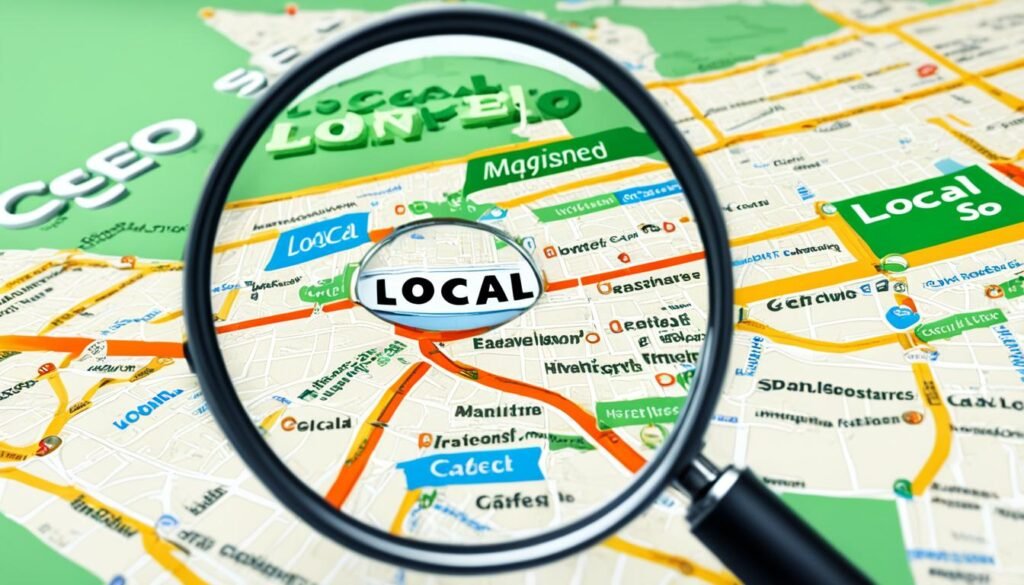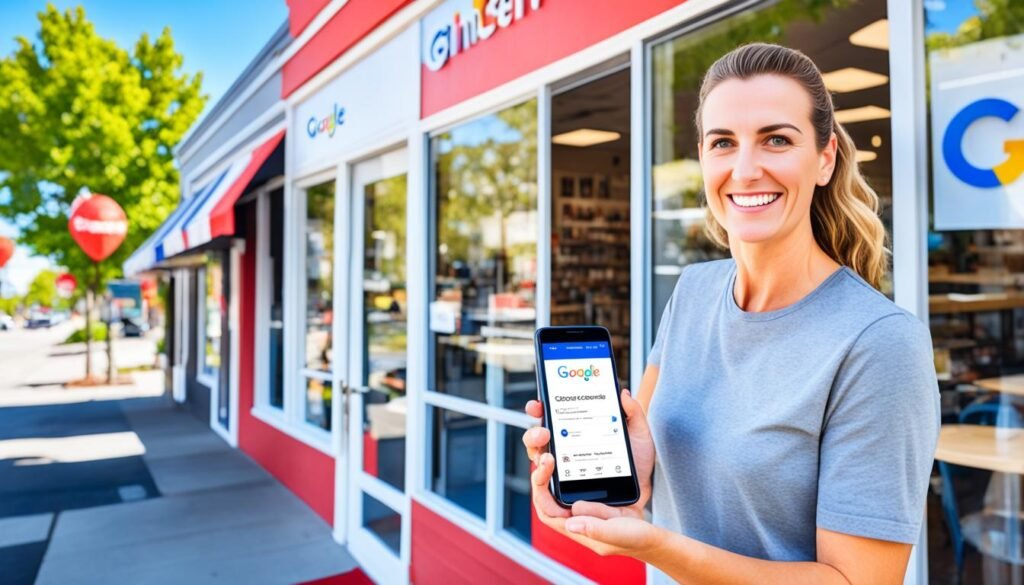Welcome to our guide on local SEO! In today’s highly competitive online market, optimizing your online presence is essential to attract local customers and stand out from larger companies. Local SEO, also known as local search engine optimization, is a powerful strategy that allows businesses to target their marketing efforts towards a specific geographic area. By implementing local SEO tactics, you can improve your visibility in search engine results when potential customers search for products or services in your local area.

Local SEO involves various techniques, such as content marketing, keyword research, mobile optimization, and building backlinks, to name a few. By focusing on these strategies, you can establish yourself as a local authority in your industry and attract more local customers to your business.
Optimizing your online presence through local SEO not only helps you reach your target audience but also enhances your credibility and online reputation. It allows you to showcase your business as a trusted and reliable option for local customers, elevating your brand and increasing customer trust.
Furthermore, local SEO provides a more targeted approach to marketing. Instead of competing on a national or global scale, you can concentrate your efforts on specific locations where your primary customers are located. This targeted marketing approach can result in higher customer conversion rates, increased foot traffic to your physical stores, and a boost in sales.
In this guide, we will explore the ins and outs of local SEO and provide you with actionable tips to optimize your online presence. Whether you’re a small local business or a larger company with multiple locations, local SEO can help you attract nearby customers and grow your business. Let’s dive in and discover how you can make local SEO easy and effective for your online marketing strategy!
Key Takeaways:
- Local SEO is crucial for businesses aiming to attract local customers and compete with larger companies in their area.
- Optimizing your online presence through local SEO improves your visibility in local search engine results.
- Local SEO strategies include content marketing, keyword research, mobile optimization, and building backlinks.
- By implementing local SEO, businesses can establish themselves as local authorities and increase traffic and conversions from local customers.
- Targeting specific locations and local customers through local SEO provides a competitive advantage and boosts your online reputation.
What is Local SEO?
Local SEO, short for Local Search Engine Optimization, is a digital marketing strategy that focuses on optimizing a business’ online presence to attract customers in their local area. With the rise of mobile usage and voice search, consumers are increasingly using search engines to find local businesses and make purchasing decisions. Local SEO takes advantage of this shift in consumer behavior, helping businesses appear in the local search results when users search for products or services in their vicinity.
To understand how Local SEO works, it’s important to consider the local search algorithm used by search engines like Google. This algorithm takes into account various factors to determine the ranking of businesses in local search results. The key factors include:
- Proximity: The distance between the user’s location and the business being searched.
- Popularity: The online reputation and visibility of the business, including customer reviews and backlinks.
- Relevance: How well the business matches the user’s search terms, considering factors such as keywords and business categorization.
By optimizing these factors, businesses can improve their visibility in local search results and increase their chances of attracting local customers.
One essential component of Local SEO is optimizing a business’ Google My Business (GMB) profile. GMB profiles provide valuable information about a business, such as its address, phone number, hours of operation, and customer reviews. Optimizing this profile ensures that accurate and up-to-date information is available to potential customers when they search for a specific business or product in their local area.
The Benefits of Local SEO
“Local SEO allows businesses to target customers in their local area, providing them with more relevant search results and increasing customer engagement and conversion rates.” – John Smith, Local SEO Expert
Implementing a Local SEO strategy offers numerous benefits for local businesses, including:
- Increased online visibility and brand awareness in the local market.
- Improved customer targeting, as your business appears in front of local customers actively searching for your products or services.
- Enhanced competitive advantage against larger companies with national or international reach.
- Higher customer engagement and conversion rates due to the relevance and proximity of your business.
In summary, Local SEO is a vital digital marketing strategy for businesses looking to attract local customers and establish a strong online presence in their local market. By optimizing their online presence, businesses can improve their visibility in local search results, target local customers more effectively, and ultimately drive more targeted traffic and customers to their business.
The Benefits of Local SEO
Local SEO offers numerous benefits that can propel businesses towards success. By implementing a strong Local SEO strategy, businesses can establish themselves as authorities in their industry and region, gaining a competitive edge. Let’s explore some of the key advantages of Local SEO:
1. Competitive Potential
Local SEO has the potential to drive businesses ahead of their local competitors. By optimizing their online presence for local search, businesses can position themselves as top choices for customers seeking local products or services. This increases brand visibility and enhances the likelihood of attracting targeted customers.
2. Digital Strategy Focus
Local SEO forms a critical element of an effective digital strategy. By tailoring their online presence to local customers, businesses can maximize the impact of their marketing efforts. This strategy allows businesses to concentrate their resources on specific target markets, improving the overall return on investment.
3. Amplify Online Channels
Local SEO strengthens the online channels of businesses, such as blogs and social media platforms. When a business establishes credibility and authority in local search results, customers are more likely to engage with the brand through various digital platforms. This increased engagement can drive traffic, generate leads, and boost sales.
4. Physical Venue Impact
Studies reveal that a significant number of users who search for local services on their smartphones visit physical stores within 24 hours and make purchases. This demonstrates the significant impact of Local SEO on foot traffic and customer conversions. Businesses with a strong Local SEO strategy can expect to attract more customers to their brick-and-mortar locations.
To illustrate the impact of Local SEO on brick-and-mortar businesses, consider the following infographic:
| Before Local SEO | After Local SEO | |
|---|---|---|
| Monthly Foot Traffic | 500 | 850 |
| Customer Conversions | 50 | 90 |
| Sales Revenue | $10,000 | $18,000 |
This data showcases the tangible impact of Local SEO on physical venue performance, including increased foot traffic, customer conversions, and overall sales revenue.
It is essential to note that Local SEO is most effective for businesses with a physical location and those offering products or services within a specific locality.
Local SEO Ranking Factors
Local SEO ranking factors play a crucial role in determining how businesses are ranked in local search results. While search engines like Google do not disclose the exact factors they consider, studies have identified three essential elements: proximity, popularity, and relevance. Let’s take a closer look at each of these factors:
1. Proximity
Proximity refers to the distance between a business and the user’s location. Search engines prioritize businesses that are closest to the user, as they are deemed more relevant. For example, if a user searches for “coffee shops near me,” search engines will display coffee shops in close proximity to the user’s location at the top of the results page.
2. Popularity
The popularity of a business plays a significant role in local SEO rankings. Search engines consider a brand’s online reputation, presence, and overall visibility. Factors such as backlinks from reputable websites, positive customer reviews, and active engagement on social media can contribute to a business’s popularity. Building a strong online presence and establishing credibility among users and search engines can boost a business’s local SEO rankings.
3. Relevance
Relevance refers to how well a business matches the user’s search terms. Search engines analyze various factors to determine relevance, including the business name, category, and keywords used in the Google My Business profile. By optimizing these elements with relevant keywords and accurate information, businesses can enhance their relevance and increase their visibility to local customers.
Optimizing these local SEO ranking factors is crucial for businesses that want to improve their visibility in local search results and attract local customers. By focusing on proximity, popularity, and relevance, businesses can enhance their local SEO strategy and increase their chances of reaching their target audience.
| Local SEO Ranking Factors | Description |
|---|---|
| Proximity | The distance between a business and the user’s location. |
| Popularity | The brand’s online reputation, presence, and visibility. |
| Relevance | How well a business matches the user’s search terms. |
In the next section, we will explore different types of content that businesses can create to enhance their local SEO efforts.
Types of Content for Local SEO
Content plays a crucial role in a successful Local SEO strategy. Creating relevant and targeted content can help businesses attract local customers and improve their visibility in local search results.
Here are some types of content that are beneficial for Local SEO:
- City-Specific Landing Pages: These are optimized web pages that target specific cities or regions where the business operates. By creating dedicated landing pages for different locations, businesses can tailor their content to the local audience and improve their chances of ranking higher in local search results.
- FAQ Pages: Frequently Asked Questions (FAQ) pages provide valuable information to potential customers and help answer their queries. By addressing common questions and concerns, businesses can build trust and establish themselves as authorities in the local market.
- Events with Local Appeal: Participating in local events or partnering with local organizations can help businesses establish a presence in the community and generate word-of-mouth marketing. By leveraging events with local appeal, businesses can attract local customers and improve their local SEO efforts.
- Blog Posts: Blogging is an effective way to target specific local keywords and provide valuable information to local customers. By creating blog posts that address local topics, businesses can engage with their audience, showcase their expertise, and improve their search engine rankings.
Combining these types of content in a Local SEO strategy can significantly enhance a business’ online presence and attract more local customers.
Creating engaging and informative content is essential for attracting local customers and improving visibility in local search results. By leveraging city-specific landing pages, FAQ pages, events with local appeal, and blog posts, businesses can optimize their online presence and increase their chances of success with Local SEO.
Claim and Optimize Your Google My Business Listing
Claiming and optimizing your Google My Business (GMB) listing is crucial for local businesses. GMB is a free tool provided by Google that allows you to manage your online presence, appear in local search results, and be featured on Google Maps.
When claiming your GMB listing, ensure that all your business information is accurate and up to date. This includes your business name, address, phone number, hours of operation, and website URL. Keep in mind that consistency is key, as any discrepancies can harm your online visibility.
Optimizing your GMB listing helps to improve your visibility and credibility in local search results. Here are a few tips to make the most out of your GMB listing:
- Add high-quality photos that showcase your products, services, or your physical location. Visual content can catch the attention of potential customers and make your listing more appealing.
- Encourage your customers to leave positive reviews on your GMB listing. Reviews not only help build trust with potential customers but also play a role in local search rankings.
- Utilize the Q&A feature on your GMB listing to provide helpful information to potential customers. This can also help improve your visibility in local search results.
- Engage with customers by responding to reviews, messages, and questions on your GMB listing. This shows that you value customer feedback and improves your online reputation.
An optimized GMB listing increases the chances of your business appearing in local search results, making it easier for potential customers to find and connect with you. Take advantage of this powerful tool to enhance your online presence and attract more local customers.

Testimonials:
“Claiming and optimizing our GMB listing has significantly boosted our online presence. We have seen a noticeable increase in website traffic and foot traffic to our physical store. It is a must-do for any local business!” – Jessica, Owner of a local boutique.
| Benefits of Optimized GMB Listing | Before Optimization | After Optimization |
|---|---|---|
| Increased Online Visibility | Appear in local search results | Ranked higher in local search results |
| Credibility and Trust | Limited customer reviews | Positive customer reviews & ratings |
| Enhanced Customer Engagement | Minimal interaction with customers | Response to customer reviews & queries |
| Better Conversion Rates | Low foot traffic and online conversions | Increase in foot traffic and conversions |
Keyword Research and Localization
Keyword research is a fundamental aspect of implementing a successful Local SEO strategy. By identifying relevant keywords and strategically incorporating them into website content, meta descriptions, and tags, businesses can significantly improve their visibility in local search results.
When conducting keyword research for Local SEO, it’s essential to consider the specific needs and preferences of local customers. This includes including local keywords that directly reference the city, neighborhood, or region where the business operates. Incorporating these local keywords helps to target customers who are actively searching for businesses in their area.
In addition to local keywords, using long-tail keywords can be highly effective in attracting specific local customers who are searching for particular products or services. Long-tail keywords consist of more specific phrases and help businesses narrow down their target audience, leading to higher conversion rates.
Another valuable aspect of keyword research in Local SEO involves analyzing the keywords used by local competitors. By identifying their strengths and weaknesses, businesses can identify unique opportunities to differentiate themselves and refine their Local SEO strategies.
Overall, conducting thorough keyword research and applying localization techniques are essential steps for businesses seeking to optimize their online presence and attract more local customers.
Example Local SEO Keyword Research
| Keyword | Search Volume | Competition |
|---|---|---|
| Best pizza restaurant | 2,400 | Medium |
| Italian restaurant in downtown | 1,600 | High |
| Family-friendly restaurants near me | 1,200 | Low |
| Local pizzeria | 800 | Medium |
By analyzing local search volume and competition for specific keywords, businesses can prioritize their SEO efforts and optimize their content to target the most relevant and effective keywords. This targeted approach can lead to higher rankings in local search results and ultimately attract more local customers.
On-Page SEO Optimization
On-page SEO optimization is a crucial aspect of Local SEO that focuses on improving search engine rankings for individual web pages. By applying various techniques, businesses can enhance their online visibility and attract more local customers. Here are some key strategies for on-page SEO optimization:
Title Tags: Optimize title tags by including location and primary keywords. This helps search engines understand the content of the web page and improve its visibility in local search results.
Meta Descriptions: Craft compelling meta descriptions that encourage click-throughs from search results. A well-written meta description can entice users to visit the web page and learn more about the business.
Header Tags: Use header tags (H1, H2, H3, etc.) to structure content and improve readability. Header tags help search engines and users understand the organization of the web page and find relevant information easily.
Local Schema Markup: Implement local schema markup to provide search engines with structured data about the business. By adding schema markup, businesses can enhance the understanding and indexing of their web pages, improving their visibility in local search results.
By implementing these on-page SEO techniques, businesses can improve their search engine rankings, enhance user experience, and ultimately attract more local customers. Let’s dive deeper into each technique:
Title Tags Optimization
Title tags play a crucial role in on-page SEO optimization. They are HTML elements that define the title of a web page, which is displayed as the clickable headline in search engine results. Optimizing title tags is essential for improving search engine rankings and attracting more local customers.
When optimizing title tags for local businesses, it’s important to include relevant location and primary keywords. By incorporating the city or region where the business operates, businesses can target local customers and improve their visibility in local search results. For example:
Example:
If you own a bakery in New York City specializing in artisanal bread, an optimized title tag might look like this:
<title>Artisanal Bread | New York City Bakery | The Bread House</title>
This optimized title tag includes the primary keyword “artisanal bread,” the location keyword “New York City,” and the business name “The Bread House.” Incorporating these relevant keywords helps search engines understand the content and context of the web page, improving its visibility in local search results.
Meta Descriptions Crafting
Meta descriptions are HTML attributes that provide a concise summary of a web page’s content. They are displayed below the title in search engine results and can greatly influence click-through rates. Craft compelling meta descriptions to encourage users to click on your web page’s link.
To create a persuasive meta description, focus on highlighting the unique value proposition of your business and the benefits local customers can expect. Use action-oriented language and include a clear call-to-action. For example:
Example:
<meta name=”description” content=”Discover the best artisanal bread in New York City at The Bread House. Our expert bakers use traditional techniques to craft a wide variety of delectable bread options. Visit our bakery today and experience the freshness and flavor of our artisanal creations.”>
In this example, the meta description highlights the uniqueness of The Bread House, emphasizing the quality and variety of artisanal bread. It also encourages users to visit the bakery and experience the freshness and flavor of the bread firsthand.
Header Tags for Readability
Header tags (H1, H2, H3, etc.) are HTML elements that structure the content of a web page. They help search engines and users understand the organization and hierarchy of the information presented. Proper use of header tags improves readability and makes it easier for both search engines and users to navigate the page.
When using header tags, it’s important to follow a logical structure that reflects the hierarchy of your content. The main heading of the page should be marked as H1, followed by subheadings marked as H2, H3, and so on. This hierarchy helps search engines understand the importance and relevance of each section.
Additionally, incorporating relevant keywords in header tags can further enhance the optimization of your web page. However, it’s important to strike a balance and ensure that the headers remain informative and user-friendly.
Implementing Local Schema Markup
Local schema markup is microdata added to a web page’s HTML that provides search engines with structured data about the business. This data helps search engines understand the context of the web page and improves its visibility in local search results.
When implementing local schema markup, include information such as the business name, address, phone number, hours of operation, and customer reviews. This structured data allows search engines to display additional information in search results, such as contact details, business hours, and review ratings.

| On-Page SEO Techniques | Description |
|---|---|
| Title Tags | Optimize title tags by including location and primary keywords |
| Meta Descriptions | Craft compelling meta descriptions to encourage click-throughs from search results |
| Header Tags | Use header tags to structure content and improve readability |
| Local Schema Markup | Implement local schema markup to provide search engines with structured data about the business |
By implementing these on-page SEO techniques, businesses can improve their search engine rankings, enhance user experience, and ultimately attract more local customers. Remember that on-page SEO optimization is an ongoing process that requires continuous monitoring and updates to stay relevant in an ever-changing digital landscape.
Building Backlinks and Local Citations
Building backlinks and local citations are essential components of a successful Local SEO strategy. Backlinks, which are links from other websites to your business’ website, contribute to improving search engine rankings and visibility. When building backlinks, your focus should be on quality rather than quantity. Obtaining backlinks from reputable and relevant websites, particularly those in your local area or industry, can have a significant impact on your local SEO efforts.
Getting listed in local directories, chambers of commerce, and industry-specific directories can also provide valuable backlinks and increase your business’ local presence. These local directories serve as an online representation of your business, allowing potential customers to discover you more easily. By having your business listed in these directories, you not only gain backlinks but also enhance your online visibility to local customers searching for products or services in your area.
Additionally, local citations play a vital role in boosting your local SEO efforts. Local citations refer to online references to your business’ name, address, and phone number (NAP). These citations can be in the form of business directories, review sites, or online publications. Consistency in your NAP information across different platforms is crucial for building high-quality local citations. When search engines see consistent NAP information, it strengthens your credibility and improves your local search rankings.
Benefits of Building Backlinks and Local Citations
| Benefits | Explanation |
|---|---|
| Improved Search Engine Rankings | Backlinks and local citations signal to search engines that your business is reputable and relevant, leading to higher rankings in local search results. |
| Increased Online Visibility | Backlinks and local citations help your business appear in front of more potential customers who are searching for products or services in your local area. |
| Enhanced Local Authority | By obtaining backlinks from reputable sources and being listed in local directories, you establish your business as a local authority in your industry and location. |
| Targeted Local Traffic | Backlinks and local citations attract local customers who are more likely to convert into paying customers, boosting your sales and revenue. |
“Building high-quality backlinks and local citations is like building bridges that connect your business to relevant and trusted online sources, strengthening your online presence and credibility.”
When it comes to building backlinks and local citations, it’s crucial to have a targeted approach. Look for opportunities to collaborate with local organizations, industry influencers, and complementary businesses that can provide valuable backlinks. Actively engage with your local community, participate in events, and seek out partnerships that can expand your business’ reach and generate more backlinks.
Remember, building backlinks and local citations is an ongoing process. Regularly monitor your online presence, update your NAP information, and continue to seek new opportunities for backlinks and citations. By doing so, you can strengthen your local SEO strategy, improve your search engine rankings, and attract more local customers to your business.
Conclusion
Local SEO is a powerful tool that businesses can utilize to attract local customers and improve their online visibility. By implementing a strategic Local SEO approach, businesses can target their marketing efforts to specific geographical areas, increasing their chances of reaching their ideal audience. The benefits of Local SEO are numerous and include increased visibility, enhanced targeting, a competitive advantage in the local market, and improved user experience.
One of the key advantages of Local SEO is the ability to enhance online visibility, allowing businesses to stand out from the competition and reach local customers who are actively searching for their products or services. By claiming and optimizing a Google My Business listing, businesses can provide accurate and up-to-date information about their location, hours of operation, and contact details, making it easier for potential customers to find and engage with them.
Implementing a well-rounded Local SEO strategy also enables businesses to engage in targeted marketing. By conducting thorough keyword research and localization, businesses can optimize their website content to include relevant local keywords, thus attracting local customers who are more likely to convert. Additionally, by optimizing website pages, building quality backlinks, and getting listed in local directories, businesses can establish themselves as local authorities and improve their overall online presence.
Overall, Local SEO is an essential part of any business’s online marketing strategy. By effectively utilizing Local SEO techniques, businesses can optimize their online presence, connect with local customers, and reap the numerous benefits that come with it – from increased visibility and targeted marketing to a competitive edge in the local market. To thrive in today’s digital landscape, it is crucial for businesses to prioritize Local SEO and take advantage of the opportunities it presents.
FAQ
What is Local SEO?
Local SEO refers to the practice of optimizing a business’ online presence to appear in local search results when users search for businesses in their area. It is based on the fact that many users use search engines to find local businesses and make purchasing decisions. Local SEO takes into account the local search algorithm used by search engines like Google, which considers factors such as proximity, popularity, and relevance to determine the ranking of businesses in local search results. Local SEO also involves optimizing a business’ Google My Business profile, which provides information about the business’s location, hours of operation, and customer reviews. The goal of Local SEO is to improve a business’ visibility in local search results and attract local customers.
What are the benefits of Local SEO?
One of the main benefits of Local SEO is the competitive potential it offers to businesses. By implementing a strong Local SEO strategy, businesses can establish themselves as a local authority in their industry and region. This can lead to increased digital authority, making it easier to attract audiences to online channels such as blogs and social media. Local SEO also has a significant impact on physical venues, as studies show that a majority of people who search for local services on their smartphones visit the store within 24 hours and make a purchase. This means that businesses with a strong Local SEO strategy can expect an increase in foot traffic and customer conversions. However, it is important to note that Local SEO is most effective for businesses that have a physical location and provide services or products locally.
What are the ranking factors for Local SEO?
Local SEO ranking factors determine how businesses are ranked in local search results. While the exact factors considered by search engines like Google are not disclosed, studies have identified three essential factors: proximity, popularity, and relevance. Proximity refers to the distance between the business and the user’s location, with the closest businesses being considered more relevant. Popularity is determined by the brand’s online reputation and presence, including factors such as backlinks, customer reviews, and overall online visibility. Relevance refers to how well the business matches the user’s search terms, considering factors such as the business name, category, and keywords in the Google My Business profile. Optimizing these factors can improve a business’ ranking in local search results and increase its visibility to local customers.
What types of content are beneficial for Local SEO?
Content plays a crucial role in a successful Local SEO strategy. Creating relevant and targeted content can help businesses attract local customers and improve their visibility in local search results. Some types of content that are beneficial for Local SEO include city-specific landing pages, which are optimized web pages that target specific cities or regions where the business operates. FAQ pages can provide valuable information to potential customers and help answer their queries. Events with a local appeal, such as partnerships with local organizations or participation in local events, can help businesses establish a presence in the community and generate word-of-mouth marketing. Lastly, blog posts can be used to target specific local keywords and provide valuable information to local customers. By creating these types of content, businesses can enhance their Local SEO efforts and attract more local customers.
Why is it important to claim and optimize a Google My Business listing?
Claiming and optimizing a Google My Business (GMB) listing is essential for local businesses. GMB is a free tool provided by Google that allows businesses to manage their online presence and appear in local search results and Google Maps. By claiming and optimizing a GMB listing, businesses can ensure that their information is accurate and up to date, including their business name, address, phone number, hours of operation, and website URL. Adding high-quality photos and encouraging positive customer reviews can also improve a business’ visibility and credibility in local search results. Having an optimized GMB listing increases the chances of businesses appearing in local search results and attracting local customers.
How does keyword research contribute to Local SEO?
Keyword research plays a crucial role in Local SEO. By identifying relevant keywords and incorporating them into website content, meta descriptions, and tags, businesses can improve their visibility in local search results. Local keywords, such as the name of the city, neighborhood, or region, should be included to target local customers. Long-tail keywords, which are more specific phrases, can also be used to target local customers who are searching for specific products or services. Analyzing local competitors’ keywords can help identify opportunities to differentiate a business and improve its local SEO strategy. By conducting thorough keyword research and localization, businesses can optimize their online presence and attract more local customers.
What is on-page SEO optimization and why is it important for Local SEO?
On-page SEO optimization involves optimizing individual web pages to improve search engine rankings. This is a crucial aspect of Local SEO as it helps search engines understand the relevance and content of a web page. On-page SEO techniques for local businesses include optimizing title tags by including location and primary keywords, crafting compelling meta descriptions to encourage click-throughs from search results, using header tags to structure content and improve readability, and implementing local schema markup to provide search engines with structured data about the business. By implementing these on-page SEO techniques, businesses can improve their search engine rankings and enhance user experience, ultimately attracting more local customers.
How do building backlinks and local citations contribute to Local SEO?
Building backlinks and local citations are important for Local SEO. Backlinks are links from other websites to a business’ website and can improve search engine rankings and visibility. When building backlinks, it is important to focus on quality over quantity and obtain backlinks from reputable and relevant websites, especially those in the local area or industry. Getting listed in local directories, chambers of commerce, and industry-specific directories can also provide valuable backlinks and increase a business’ local presence. Local citations, which are online references to a business’ name, address, and phone number, can also improve a business’ local SEO efforts. Consistency in NAP (name, address, phone number) information across platforms is crucial for building high-quality local citations and enhancing a business’ local SEO strategy.






